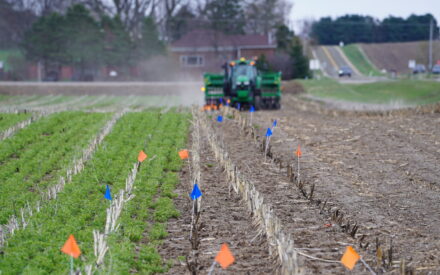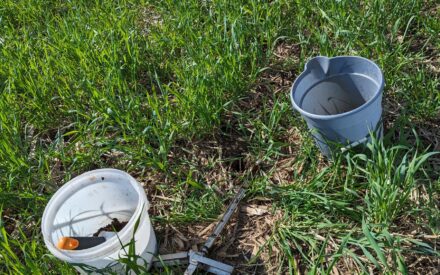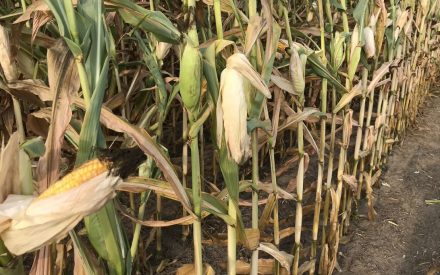Over the past two decades, brown midrib (BMR) corn hybrids have been a key tool for growers focused on producing high-quality corn silage. BMR corn hybrids are valued for their higher fiber digestibility levels, due to their lower lignin levels, when compared to conventional corn.
Higher digestibility not only produces better quality feed but may increase dry matter intake (DMI), resulting in more milk production for high-producing dairy cows. Additionally, farmers may be able to reduce the quantity of concentrates and purchased supplements in their rations, resulting in lower overall feed costs.
While not every farm elects to grow and harvest BMR corn silage, these hybrids are a major forage component for many dairy herds across Wisconsin. It is not uncommon for a lactating dairy ration to contain at least 60% forages. Furthermore, it is also not unusual for 65% of that 60% forage component to be corn silage. Recent announcements from Corteva (Pioneer, Brevant, and Dairyland Seed) indicate that farmers need to plan for the eventual phase out of BMR products from the associated companies no later than the 2030 growing season.
What’s in development that could offer producers a balance of yield and fiber digestibility comparable to today’s leading corn silage options?
Conventional BMR Management Changes
BMR hybrid options will still be available but will likely be limited in supply and may not have the insect and herbicide tolerance trait packages we’re accustomed to working with. If maximizing silage digestibility is still your top priority and you’re considering making the switch to a conventional BMR hybrid, plan ahead for changes in crop management and consider the differences in cost. This includes different herbicide programs, insecticide treatments, and the cost of the seed. Keep in mind fungicides may also be warranted in some situations since hybrids without insect protection traits are more susceptible to ear rot and mycotoxin accumulations following insect damage.
New Corn Silage Hybrid Varieties
New hybrids coming to the market may bring some potential for quality silage with them. Besides the inherent differences seen between hybrids, short-statured corn is being evaluated as a possible tool to produce high-quality silage. First-year research done by Dr. Harkirat Kaur, Corn Production Systems Agronomist at the University of Wisconsin, has shown that short corn has the potential to produce higher neutral detergent fiber digestibility (NDFD) than standard corn while maintaining a similar grain yield. The improved digestibility is often credited to the reduced percentage of lignin-dense stalk material in the overall tonnage. The digestibility of short corn silage is not at the level of BMR hybrids but still looks to be a promising tool for silage producers who choose to phase out BMR.
Biological Products to Improve Silage Quality
In addition to corn hybrid developments, it may be possible to improve silage quality with the use of certain biological products. “Biologicals” are a broad category describing products made from living or naturally occurring materials, often bacteria or enzymes, which are intended to complement and enhance the functions of plants. Traditional silage inoculants fall into this category, but there’s also been a significant increase in developments of potential seed treatments and foliar applications. Regarding enhancing silage quality, these products are geared towards improving fiber digestibility. While these possibilities are exciting, this realm of the crop science marketplace is vast and relatively unregulated. Testing and evaluation will be crucial to determining which product types will be most effective.
What management factors can farmers adjust to maximize milk per ton (MPT)?
NDFD30 and Milk Quality
Regardless of future developments in corn silage technology, farmers can always manage basic factors when trying to maximize the quality, or milk per ton (MPT), of their corn silage enterprises. It all begins with selecting hybrids that perform above average on neutral detergent fiber digestibility at 30 hours (NDFD30). Most conventional corn silage hybrids range from 47%-67% NDFD30, while BMR hybrids have consistently demonstrated values ranging from 54%-74%. Selecting a high performing conventional hybrid at 60%-65% NDFD30 has the potential to yield similar or more MPT than an average performing BMR hybrid. A one-percent improvement in NDFD30 in the overall ration is estimated to increase milk production by 0.55 lbs. of milk per cow per day.
Corn Planting Population
University of Wisconsin-Madison Division of Extension research has demonstrated corn planting population can influence corn silage quality. Research on corn row spacing and population conducted in partnership with the Midwest Forage Association demonstrated that 30,000 plants per acre yielded statistically higher NDFD than corn silage planted at 35,000 or 40,000 plants per acre. However, it is believed that increasing corn planting population may increase dry matter (DM) yield until a certain maximum seeding rate is reached. Farmers need to consider the potential impact on MPT, and potential elevated insect damage of this management strategy. Specific hybrids may respond differently to the general relationship between plant population and silage quality depending on the soil type, fertility, plant spacing, and weather conditions experienced during any individual growing season.
Silage Cutting Height
Corn silage cutting height can also be adjusted to increase the quality of corn silage. Research conducted by former UW-Madison Corn Agronomist, Dr. Joe Lauer, demonstrated that MPT was greatest at a cutter bar height of 18-inches and lowest at a cutter bar height of 6-inches, however, corn silage yield decreased by 15% at the 18-inch height compared to the 6-inch cutting height. Higher cutting heights can increase the starch concentration in the corn silage. This may be why only a 3%-4% reduction in Milk Per Acre (MPA) was observed when raising the cutter bar height by 12-inches. More work may need to be done in this area before any general recommendation can be made given current genetics/traits available in hybrids.
Even with the best hybrid, fertility, and pest control, harvest timing and processing remain critical. If silage isn’t harvested at the right moisture or chopped to fit the storage structure, its full feed value can’t be realized which limits ration quality for the next 12 months.
So, as we look ahead, the question becomes: What steps can farms take today to secure forage quality and performance for tomorrow?
As some BMR hybrids begin to phase out, the future of high-quality corn silage will depend on how well we adapt, from evaluating new hybrids like short-statured corn, to exploring biological products and fine-tuning management practices like plant population and cutting height. At the end of the day, no single factor determines silage quality. It’s the combination of genetics, agronomy, and harvest management that drives milk per ton and profitability.
Updated: Aug. 11, 2025
Reviewed by: Harkirat Kaur

 ▶ Unlocking the Potential of Biological Nitrogen Fixation in Corn
▶ Unlocking the Potential of Biological Nitrogen Fixation in Corn ▶ Considerations for 2026 Seed Selection
▶ Considerations for 2026 Seed Selection ▶ Evaluating MRTN Rates for Corn Grain and Silage After Manure Application
▶ Evaluating MRTN Rates for Corn Grain and Silage After Manure Application ▶ Practices to Optimize the Nutritive Value of Corn Silage
▶ Practices to Optimize the Nutritive Value of Corn Silage


